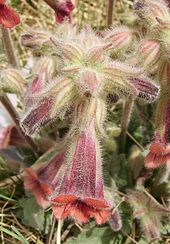Rehmannia
| Rehmannia | |
|---|---|

| |
| Flowers of Rehmannia glutinosa | |
| Scientific classification | |
| Kingdom: | Plantae |
| Clade: | Tracheophytes |
| Clade: | Angiosperms |
| Clade: | Eudicots |
| Clade: | Asterids |
| Order: | Lamiales |
| Family: | Orobanchaceae |
| Tribe: | Rehmannieae Rouy 1909 [1] |
| Genus: | Rehmannia Libosch. ex Fisch. & C.A. Mey. |
| Species | |
Rehmannia is a genus of seven species of
Systematics
Etymology
Rehmannia is named for Joseph Rehmann (1788–1831), a physician in
Homonymy
The name "Rehmannia" has also been given to a
Classification
The genus was included in the family Scrophulariaceae or Gesneriaceae in some older classifications. The current placement of the genus is in neither Scrophulariaceae s.s. nor Plantaginaceae s.l. (to which many other former Scrophulariaceae have been transferred). Earlier molecular studies suggested that its closest relatives were the genera Lancea and Mazus,[6] which have been included in Phrymaceae.[7] Subsequently, it was found that Rehmannia groups with Triaenophora, and both taxa are jointly the sister group to Lindenbergia and the parasitic Orobanchaceae.[8] A 2016 classification of flowering plants, the APG IV system enlarged Orobanchaceae to include Rehmannia,[9] making it one of the few genera in the family, along with Lindenbergia, not to be parasitic.
Species list
As of March 2022[update], Plants of the World Online accepted six species:[10]
| Image | Scientific Name | Distribution |
|---|---|---|
| Rehmannia chingii H.L.Li | China | |
| Rehmannia chrysantha M.H.Li & C.H.Zhang | Inner Mongolia | |
 |
Rehmannia glutinosa (Gaertn.) DC. | China |
| Rehmannia henryi N.E.Br. | China (Hubei) | |
| Rehmannia japonica (Thunb.) Makino | Japan (C. Honshu). | |
 |
Rehmannia piasezkii Maxim. | China (Hubei, Shanxi) |
| Rehmannia solanifolia P.C.Tsoong & T.L.Chin | China (Sichuan) |
Uses
Sometimes known as Chinese foxglove due to its superficial resemblance to the genus Digitalis, the species of Rehmannia are perennial herbs. The plants have large flowers and are grown as ornamental garden plants in Europe and North America, and are used medicinally in Asia.
Traditional Chinese medicine
Known as dìhuáng (
It is the main ingredient in a mixture called si wu tang (four substance decoction) along with
When two ingredients, peach (tao ren) and safflower (hong hua), are added, it is called tao hong si wu tang (four substance decoction with peach pit and safflower), which is used in TCM for fatigue.[12]
Chemical constituents
Rehmannia contains the vitamins A, B, C, and D,[citation needed] as well as other compounds, such as catalpol, an iridoid glycoside.
References
- ^ a b Rouy, G. (1909). "Conspectus des tribus et des genres de la famille des Scrofulariacées". Rev. Gen. Bot. 21: 194–207.
- ^ "Rehmannia in Flora of China @ efloras.org". www.efloras.org. Retrieved 2020-05-10.
- ISBN 978-3-642-18617-2.
- PMID 31379896.
- ISBN 9780521685535(paperback). pp 328
- JSTOR 25065369.
- PMID 21665709.
- PMID 21628207.
- .
- ^ "Rehmannia Libosch. ex Fisch. & C.A.Mey.". Plants of the World Online. Royal Botanic Gardens, Kew. Retrieved 2022-03-21.
- ^ Jim English (2010). "Traditional Chinese Herbs for Arthritis". Nutrition Review. 5 (2). Archived from the original on 2011-12-10. Retrieved 2011-12-29.
- ^ ISBN 9780203493892.
